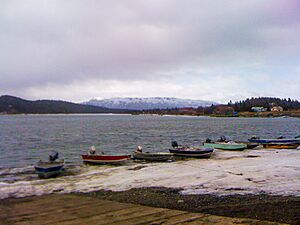Wood-Tikchik State Park facts for kids
Quick facts for kids Wood-Tikchik State Park |
|
|---|---|
 |
|
| Location | Southwest Alaska |
| Nearest city | Dillingham |
| Area | 650,000 ha (2,500 sq mi) |
| Designation | State Park |
| Established | 1978 |
| Governing body | Alaska Department of Natural Resources |
Wood-Tikchik State Park is a huge state park in Alaska, a state in the United States. It is located north of the city of Dillingham. This park is incredibly large, covering more than 1.6 million acres (6,500 square kilometers). That's about the same size as the entire state of Delaware!
Wood-Tikchik State Park makes up over half of all the state park land in Alaska. It also accounts for 15% of all state park land in the entire country. Even though it's the biggest state park in the nation, it had no staff for its first five years. Sometimes, only one park ranger is in charge of looking after the whole park, often by flying in an aircraft.
Contents
What is the History of Wood-Tikchik Park?
For hundreds of years before Europeans arrived, the Yup'ik people lived in the area that is now the park. In 1818, a group from Russia explored the rivers and set up a fur trading post. This post stayed active until 1867, when the United States bought Alaska.
The National Park Service once thought about managing this area. However, in 1978, the Alaska State Legislature voted to make it a state park instead.
How Can You Visit Wood-Tikchik State Park?
This park is in a very remote location, meaning it's far away from cities and main roads. You cannot drive to the park using the regular road system. The only road access is from Dillingham, which has an airport with regular flights.
Many visitors fly into the park using special floatplanes. These planes can land on one of the many lakes inside the park. All lakes in the park are open for floatplane landings. You can also reach the Wood River lake system by boat, traveling along the Wood River itself.
There are a few private lodges inside the park where you can stay, but you need to book them in advance. You can camp anywhere in the park, but some areas require a special permit. Park managers really want visitors to practice "Leave No Trace" camping. This means you should leave the area exactly as you found it. Fires are only allowed on beaches, gravel bars, or in the few fire pits provided.
Why is Conservation Important Here?
The park is kept mostly as undeveloped wilderness on purpose. Different conservation groups work to buy land parcels within the park. They either hold this land to protect it or sell it back to the park system.
This has sometimes caused disagreements with groups who want to develop the land. This includes some Yup'ik native people. They have land claims that were made before the park was created and would like to develop on them.
The park is next to other large protected areas. To its west is the Togiak National Wildlife Refuge. To its northwest is the Yukon Delta National Wildlife Refuge. Together, these areas create a huge amount of remote wilderness on public lands.
What Wildlife Lives in the Park?
Wood-Tikchik State Park is a very important home for many different animals. A main reason the park exists is to protect areas where salmon lay their eggs. All five main types of salmon breed in the park. Sockeye salmon are especially important for people who fish for food in the area.
Other animals you might see in the park include whitefish, black bears, brown bears, moose, caribou, wolverines, marmots, porcupines, otters, and foxes. If you have the right permits, you can hunt large animals in the park for sport or for food.
Exploring the Lakes and Rivers
The park's name comes from two different lake systems within its borders. The lakes in the southern part of the park form the Wood River. This river flows into Bristol Bay. The lakes in the northern part, called the Tikchik lakes, empty into the Nuyakuk River. This river is a branch of the Nushagak River, which also flows into Bristol Bay.
The lakes of the Wood River system are all connected by streams. This creates a "water trail" that is over 85 miles long. The lakes in both systems are large and deep. They can be from 15 to 45 miles long. Their deepest points range from 342 to 940 feet. A dozen of these lakes have more than 1,000 acres of surface area. There are also rivers connecting the lake systems that are as long as 60 miles, all within the park's boundaries.
Lake Aleknagik: A Gateway to the Park
Wood-Tikchik is one of only two state parks in Southwest Alaska. The other is Lake Aleknagik State Recreation Site. This is a small 11-acre park. Its main purpose is to be a starting point for visiting the much larger Wood-Tikchik Park. Local people call it "first lake" because it gives access to the many lakes upstream. This site has a boat launch, sells gas and aviation fuel, and is home to the ranger headquarters for both state parks.


